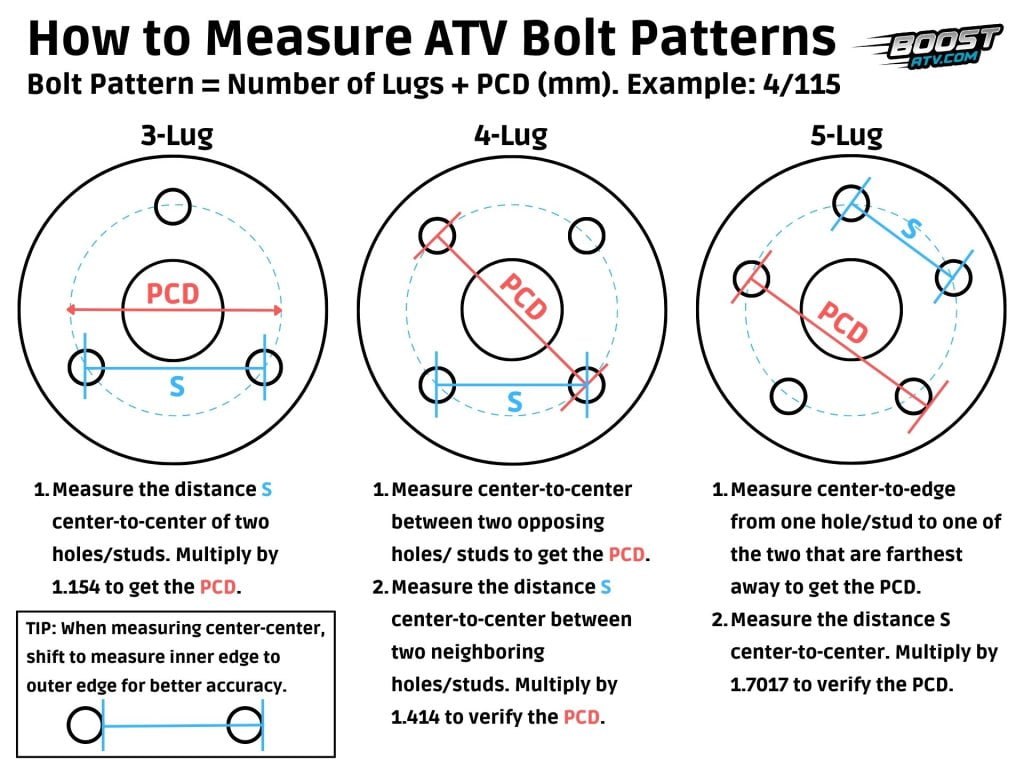Decoding the 4-Lug Bolt Pattern Mystery: Your Wheel Fitment Guide

Ever stared at a wheel, bewildered by the seemingly cryptic arrangement of its lug bolts? You're not alone. The world of wheel bolt patterns can be a confusing landscape, especially for those new to car modifications or maintenance. This guide aims to demystify the most prevalent 4-lug configurations, offering a deep dive into their history, significance, and practical implications.
The four-lug bolt pattern, a cornerstone of automotive wheel design, dictates how a wheel attaches to a vehicle's hub. It's a critical factor in ensuring safe and reliable driving. Choosing the incorrect bolt pattern can lead to disastrous consequences, from wheel wobble to complete detachment. Understanding this fundamental aspect of wheel fitment is crucial for any car owner.
Among the various 4-lug setups, the 4x100mm bolt pattern reigns supreme as the most common. This configuration, often abbreviated as 4x100 or 4/100, indicates four lug holes spaced 100 millimeters apart on a circle known as the bolt circle diameter (BCD). Its widespread adoption can be attributed to its use on a vast range of small cars and compact vehicles, solidifying its place as the dominant 4-lug standard.
The historical trajectory of the 4-lug bolt pattern is intertwined with the evolution of the automobile itself. As cars transitioned from horse-drawn carriages to motorized vehicles, the need for a standardized and efficient method of wheel attachment became apparent. The 4-lug design emerged as a balance between strength, simplicity, and cost-effectiveness, especially for smaller, lighter vehicles. This led to its widespread adoption, particularly in the early to mid-20th century.
The importance of a correctly matched 4-lug bolt pattern cannot be overstated. It directly impacts vehicle safety, handling, and overall performance. A mismatched pattern can cause vibrations, uneven tire wear, and even wheel separation, leading to potentially dangerous driving conditions. Ensuring a proper fit is paramount for both driver and passenger safety.
One common issue related to 4-lug wheels is the potential for confusion with other similar patterns. For instance, a 4x98 pattern might appear very close to a 4x100, but even a 2mm difference can prevent proper fitment and create significant safety hazards. Careful measurement and confirmation are essential to avoid such issues.
A key benefit of the common 4x100 pattern is the wide availability of compatible wheels. This offers car owners a vast selection of aftermarket options, allowing for customization and personalization. This abundance of choice makes it easier to find wheels that match specific aesthetic preferences and performance requirements.
Another advantage lies in the generally lower cost of 4-lug wheels compared to those with more complex patterns. This affordability makes them an attractive option for budget-conscious car owners seeking replacements or upgrades.
Furthermore, the relative simplicity of the 4-lug design makes installation and maintenance generally straightforward. Changing a tire with a 4-lug wheel is typically quicker and easier than with a 5- or 6-lug setup.
Advantages and Disadvantages of the Most Common 4-Lug Bolt Pattern
| Advantages | Disadvantages |
|---|---|
| Wide availability of wheels | Generally less robust than 5- or 6-lug patterns |
| Lower cost | Limited choices for larger or high-performance vehicles |
| Easier installation and maintenance | Susceptible to wobble if not properly installed |
Best practice for identifying your bolt pattern is to consult your vehicle's owner's manual or check the markings on the back of your existing wheels. Never rely solely on visual estimations.
FAQ:
What is a bolt circle diameter (BCD)? The BCD is the diameter of the circle formed by the centers of the lug holes.
How do I measure my bolt pattern? Use a ruler or caliper to accurately measure the distance between the center of two opposite lug holes.
In conclusion, the most common 4-lug bolt pattern, specifically the 4x100, plays a pivotal role in the automotive world. While it may seem like a minor detail, its impact on safety, performance, and customization is significant. Understanding its history, importance, and associated challenges allows car owners to make informed decisions about wheel selection and maintenance. By adhering to best practices and ensuring proper fitment, drivers can enjoy the benefits of this widely adopted standard while prioritizing safety and performance on the road. Remember, accurate measurement and verification are crucial for a secure and enjoyable driving experience. Take the time to double-check your bolt pattern before installing new wheels – your safety depends on it.
Mastering three digit addition without carrying
Grip it the art of ball retention
Craigslist killeen ft hood texas your local marketplace guide







